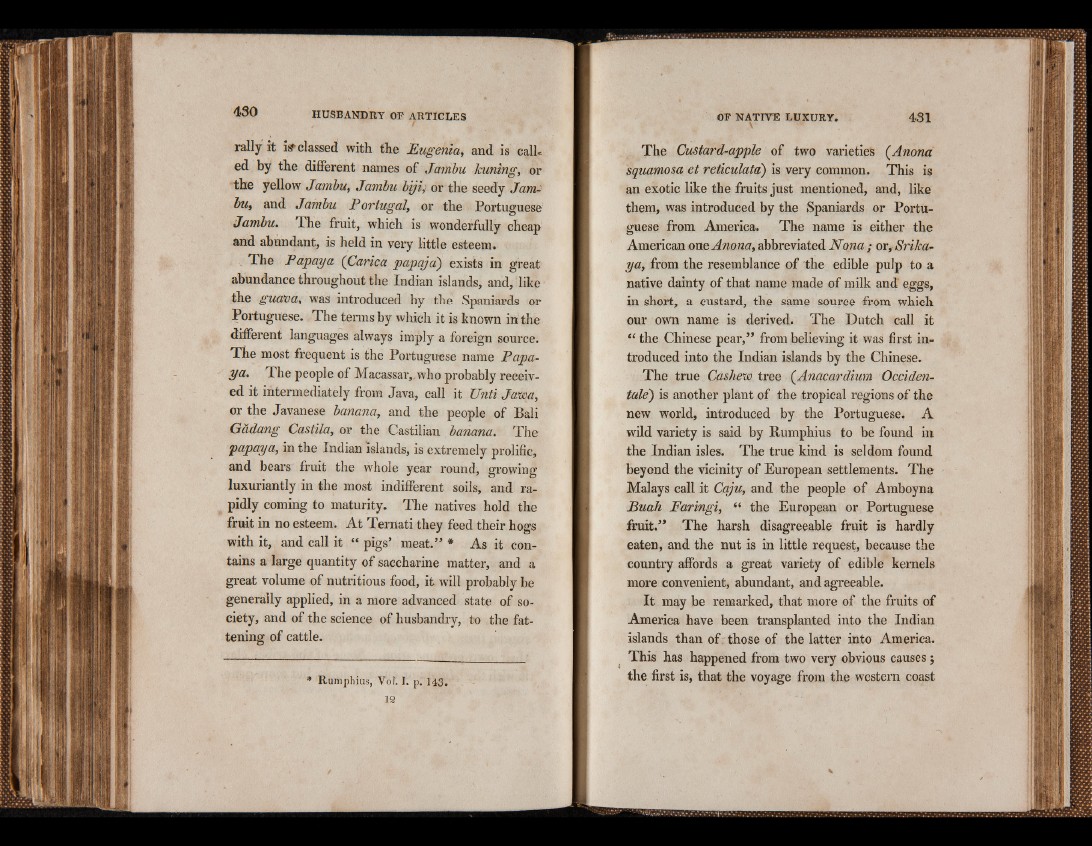
rally it isf classed with the Eugenia * and is call«
ed by the different names of Jambu Jcuning, or
the yellow Jambu, Jambu biji, or the seedy Jambu,
and Jambu Portugal or the Portuguese
Jambu. The fruit, which is wonderfully cheap
and abundant, is held in very little esteem.
The Papaya (Carica papaja) exists in great
abundance throughout the Indian islands, and, like
the guava, was introduced by the Spaniards or
Portuguese. The terms by which it is known in the
different languages always imply a foreign source.
The most frequent is the Portuguese name Papaya.
The people of Macassar,.who probably received
it intermediately from Java, call it XJnti Jama,
or the Javanese banana, and the people of Bali
Gâdang Castila, or the Castilian banana. The
papaya, in the Indian islands, is extremely prolific,
and bears fruit the whole year round, growing
luxuriantly in the most indifferent soils, and rapidly
coming to maturity. The natives hold the
fruit in no esteem. At Ternati they feed their hogs
with it, and call it “ pigs’ meat.” * As it contains
a large quantity of saccharine matter, and a
great volume of nutritious food, it will probably be
generally applied, in a more advanced state of society,
and of the science of husbandry, to the fattening
of cattle.
* Rumphius, Vol. I. p. 143.
12
The Custard-apple of two varieties (Anona
squamosa et reticulata) is very common. This is
an exotic like the fruits just mentioned, and, like
them, was introduced by the Spaniards or Portuguese
from America. The name is either the
American one Anona, abbreviated Nona ; or, Srika-
ya, from the resemblance of the edible pulp to a
native dainty of that name made of milk and eggs,
in short, a custard, the same source from which
our own name is derived. The Dutch call it
“ the Chinese pear,” from believing it was first introduced
into the Indian islands by the Chinese.
The true Cashew tree (Anacardium Occiden-
tale') is another plant of the tropical regions of the
new world, introduced by the Portuguese. A
wild variety is said by Rumphius to be found in
the Indian isles. The true kind is seldom found
beyond the vicinity of European settlements. The
Malays call it Caju, and the people of Amboyna
Euah Faringi, “ the European or Portuguese
fruit.” The harsh disagreeable fruit is hardly
eaten, and the nut is in little request, because the
country affords a great variety of edible kernels
more convenient, abundant, and agreeable.
It may be remarked, that more of the fruits of
America have been transplanted into the Indian
islands than of r those of the latter into America.
This has happened from two very obvious causes j
the first is, that the voyage from the western coast